Nanoremediation and Antioxidant Potential of Biogenic Silver Nanoparticles Synthesized Using Leucena’s Leaves, Stem, and Fruits
Abstract
1. Introduction
2. Results
2.1. Phenolic Compounds’ Dosage in Crude Extracts Obtained at Different Temperatures
2.2. Phenolic Compounds’ Dosage in Crude Extracts Obtained in Different Time Intervals
2.3. Nanoremediation Assay with AgNPs Produced Using Different AgNO3: Extract Proportions
2.4. AgNPs Characterization
2.5. Nanoremediation Assay Using Different Concentrations of AgNPs
2.6. Dyes’ Adsorption Kinetics
2.7. Antioxidant Assay
3. Discussion
4. Materials and Methods
4.1. Preparation of Plant Material
4.2. Crude Extract Obtainment at Different Temperatures
4.3. Phenolic Compounds’ Dosage
4.4. Crude Extracts Obtainment in Different Time Intervals
4.5. AgNPs Synthesis
4.6. Nanoremediation Assay
4.7. AgNPs’ Characterization
4.8. Dyes’ Adsorption Kinetics
4.9. Antioxidant Assay
5. Conclusions
6. Patents
Author Contributions
Funding
Institutional Review Board Statement
Informed Consent Statement
Data Availability Statement
Conflicts of Interest
References
- Longman, J.; Veres, D.; Finsinger, W.; Ersek, V. Exceptionally high levels of lead pollution in the Balkans from the Early Bronze Age to the Industrial Revolution. Proc. Natl. Acad. Sci. USA 2018, 115, E5661–E5668. [Google Scholar] [CrossRef] [PubMed]
- Yamada, D.; Hiwatari, M.; Hangoma, P.; Narita, D.; Mphuka, C.; Chitah, B.; Yabe, J.; Nakayama, S.M.M.; Nakata, H.; Choongo, K.; et al. Assessing the population-wide exposure to lead pollution in Kabwe, Zambia: An econometric estimation based on survey data. Sci. Rep. 2020, 10, 15092–15103. [Google Scholar] [CrossRef] [PubMed]
- Chaoua, S.; Boussaa, S.; El Gharmali, A.; Boumezzough, A. Impact of irrigation with wastewater on accumulation of heavy metals in soil and crops in the region of Marrakech in Morocco. J. Saudi Soc. Agric. Sci. 2019, 18, 429–436. [Google Scholar] [CrossRef]
- Iloms, E.; Ololade, O.O.; Ogola, H.J.O.; Selvarajan, R. Investigating Industrial Effluent Impact on Municipal Wastewater Treatment Plant in Vaal, South Africa. Int. J. Environ. Res. Public Health 2020, 17, 1096. [Google Scholar] [CrossRef] [PubMed]
- Zheng, H.; Zhang, C.; Liu, B.; Liu, G.; Zhao, M.; Xu, G.; Luo, X.; Li, F.; Xing, B. Biochar for Water and Soil Remediation: Production, Characterization, and Application. In A New Paradigm for Environmental Chemistry and Toxicology, 1st ed.; Jiang, G., Li, X., Eds.; Springer: Singapore, 2020; pp. 153–196. [Google Scholar] [CrossRef]
- Chandanshive, V.; Kadam, S.; Rane, N.; Jeon, B.H.; Jadhav, J.; Govindwar, S. In situ textile wastewater treatment in high rate transpiration system furrows planted with aquatic macrophytes and floating phytobeds. Chemosphere 2020, 252, 1265–1273. [Google Scholar] [CrossRef] [PubMed]
- Pandey, A.; Shukla, P.; Srivastava, P.K. Remediation of Dyes in Water using Green Synthesized Nanoparticles. Int. J. Plant Environ. 2020, 6, 68–84. [Google Scholar] [CrossRef]
- Mudhoo, A.; Ramasamy, D.L.; Bhatnagar, A.; Usman, M.; Sillanpää, M. An analysis of the versatility and effectiveness of compounds for sequestering heavy metal ions, dyes and xenobiotics from soils and aqueous milieus. Ecotoxicol. Environ. Saf. 2020, 197, 587–598. [Google Scholar] [CrossRef] [PubMed]
- Patil, R.; Zahid, M.; Govindwar, S.; Khandare, R.; Vyavahare, G.; Gurav, R.; Desai, N.; Pandit, S.; Jadhav, J. Constructed wetland: A promising technology for the treatment of hazardous textile dyes and effluent. In Development in Wastewater Treatment Research and Processes, 1st ed.; Shah, M., Rodriguez-Couto, S., Biswas, J., Eds.; Elsevier: New York, NY, USA, 2022; pp. 173–198. [Google Scholar] [CrossRef]
- Razavi, R.; Amiri, M.; Alshamsi, H.A.; Eslaminejad, T.; Salavati-Niasari, M. Green Synthesis of Ag nanoparticles in oil-in-water nano-emulsion and evaluation of their antibacterial and cytotoxic properties as well as molecular docking. Arab. J. Chem. 2021, 14, 323–334. [Google Scholar] [CrossRef]
- Samsami, S.; Mohamadizaniani, M.; Sarrafzadeh, M.H.; Rene, E.R.; Firoozbahr, M. Recent advances in the treatment of dye-containing wastewater from textile industries: Overview and perspectives. Process Saf. Environ. Prot. 2020, 143, 138–163. [Google Scholar] [CrossRef]
- Shindhal, T.; Rakholiya, P.; Varjani, S.; Pandey, A.; Ngo, H.H.; Guo, W.; Ng, H.Y.; Taherzadeh, M.J. A critical review on advances in the practices and perspectives for the treatment of dye industry wastewater. Bioengineered 2021, 12, 70–87. [Google Scholar] [CrossRef]
- Sardar, M.; Manna, M.; Maharana, M.; Sen, S. Remediation of Dyes from Industrial Wastewater Using Low-Cost Adsorbents. In Green Adsorbents to Remove Metals, Dyes and Boron from Polluted Water, 1st ed.; Inamuddin, Ahamed, M.I., Lichtfouse, E., Asiri, A.M., Eds.; Springer: Cham, Switzerland, 2020; pp. 377–403. Available online: https://link.springer.com/chapter/10.1007/978-3-030-47400-3_15 (accessed on 8 February 2024).
- Pandikumar, A.; Jothivenkatachalam, K. Photocatalytic Functional Materials for Environmental Remediation, 1st ed.; John Wiley & Sons Inc.: Hoboken, NJ, USA, 2019; p. 377. [Google Scholar] [CrossRef]
- Homaeigohar, S. The Nanosized Dye Adsorbents for Water Treatment. Nanomaterials 2020, 10, 295. [Google Scholar] [CrossRef] [PubMed]
- Bolade, O.P.; Williams, A.B.; Benson, N.U. Green synthesis of iron-based nanomaterials for environmental remediation: A review. Environ. Nanotechnol. Monit. Manag. 2020, 13, 279–292. [Google Scholar] [CrossRef]
- Lu, F.; Astruc, D. Nanocatalysts and other nanomaterials for water remediation from organic pollutants. Coord. Chem. Rev. 2020, 408, 213180. [Google Scholar] [CrossRef]
- Nasrollahzadeh, M.; Sajjadi, M.; Iravani, S.; Varma, R.S. Green-synthesized nanocatalysts and nanomaterials for water treatment: Current challenges and future perspectives. J. Hazard. Mater. 2021, 401, 401–412. [Google Scholar] [CrossRef] [PubMed]
- Savina, I.N.; Otero-Gonzalez, L.; Berillo, D. Macroporous Cryogel-Based Systems for Water Treatment Applications and Safety: Nanocomposite-Based Cryogels and Bacteria-Based Bioreactors. In Biomedical Applications and Toxicity of Nanomaterials, 1st ed.; Mohanan, P.V., Kappalli, S., Eds.; Springer: Singapore, 2023; pp. 1–49. [Google Scholar] [CrossRef]
- Fiorati, A.; Bellingeri, A.; Punta, C.; Ilaria Corsi, I.; Venditti, I. Silver Nanoparticles for Water Pollution Monitoring and Treatments: Ecosafety Challenge and Cellulose-Based Hybrids Solution. Polymers 2020, 12, 1635. [Google Scholar] [CrossRef] [PubMed]
- Isa, N.; Lockman, Z. Methylene blue dye removal on silver nanoparticles reduced by Kyllinga brevifolia. Environ. Sci. Pollut. Res. 2019, 26, 11482–11495. [Google Scholar] [CrossRef] [PubMed]
- Gowda, S.A.M.; Goveas, L.C.; Dakshayini, K. Adsorption of methylene blue by silver nanoparticles synthesized from Urena lobata leaf extract: Kinetics and equilibrium analysis. Mater. Phys. Chem. 2022, 288, 126431. [Google Scholar] [CrossRef]
- Jaast, S.; Grewal, A. Green synthesis of silver nanoparticles, characterization and evaluation of their photocatalytic dye degradation activity. Curr. Opin. Green Sustain. Chem. 2021, 4, 100195. [Google Scholar] [CrossRef]
- Bahrulolum, H.; Nooraei, S.; Javanshir, N.; Tarrahimofrad, H.; Mirbagheri, V.S.; Easton, A.J.; Ahmadian, G. Green synthesis of metal nanoparticles using microorganisms and their application in the agrifood sector. J. Nanobiotechnol. 2021, 19, 86–92. [Google Scholar] [CrossRef]
- Ahmad, N.; Sharma, S. Green synthesis of silver nanoparticles using extracts of Ananas comosus. Green Sustain. Chem. 2012, 2, 141–147. [Google Scholar] [CrossRef]
- Khan, M.; Khan, M.; Adil, S.F.; Tahir, M.N.; Tremel, W.; Alkhathlan, H.Z.; Al-Warthan, A.; Siddiqui, M.R.H. Green synthesis of silver nanoparticles mediated by Pulicaria glutinosa extract. Int. J. Nanomed. 2013, 8, 1507–1516. [Google Scholar] [CrossRef]
- Liu, Y.S.; Chang, Y.C.; Chen, H.H. Silver nanoparticle biosynthesis by using phenolic acids in rice husk extract as reducing agents and dispersants. J. Food Drug Anal. 2018, 26, 649–656. [Google Scholar] [CrossRef] [PubMed]
- Vidhu, V.K.; Aromal, S.A.; Philip, D. Green synthesis of silver nanoparticles using Macrotyloma uniflorum. Spectrochim. Acta Part A Mol. Biomol. Spectrosc. 2011, 83, 392–397. [Google Scholar] [CrossRef] [PubMed]
- Ahsan, A.; Farooq, M.A.; Bajwa, A.A.; Parveen, A. Green Synthesis of Silver Nanoparticles Using Parthenium hysterophorus: Optimization, Characterization and In Vitro Therapeutic Evaluation. Molecules 2020, 25, 3324. [Google Scholar] [CrossRef] [PubMed]
- Mohammadi, F.; Yousefi, M.; Ghahremanzadeh, R. Green synthesis, characterization and antimicrobial activity of silver nanoparticles (AgNPs) using leaves and stems extract of some plants. Adv. J. Chem. A 2019, 2, 266–275. [Google Scholar] [CrossRef]
- Rao, A.N.; Singh, R.G.; Mahajan, G.; Wani, S.P. Weed research issues, challenges, and opportunities in India. Crop Prot. 2020, 134, 104–113. [Google Scholar] [CrossRef]
- Machado, M.T.S.; Drummond, J.A.; Barreto, C.G. Leucaena ieucocephala (Lam.) de Wit in Brazil: History of an invasive plant. Estud. Ibero-Am. 2020, 46, 976–988. [Google Scholar] [CrossRef]
- Zhang, H.; Jiang, K.; Zhao, Y.; Xing, Y.; Ge, H.; Cui, J.; Liu, T.; Wang, C. A Trait-Based Protocol for the Biological Control of Invasive Exotic Plant Species. Front. Ecol. Evol. 2021, 9, 948–961. [Google Scholar] [CrossRef]
- Taher, M.A.; Khojah, E.; Darwish, M.S.; Elsherbiny, E.A.; Elawady, A.A.; Dawood, D.H. Biosynthesis of Silver Nanoparticles by Polysaccharide of Leucaena ieucocephala Seeds and Their Anticancer, Antifungal Properties and as Preservative of Composite Milk Sample. J. Nanomater. 2022, 2022, 221–232. [Google Scholar] [CrossRef]
- Serunting, M.A.; Maryana, O.F.T.; Syafitri, E.; Balqis, S.; Windiastuti, E. Green Synthesis Silver Nanoparticles (AgNPs) Using Lamtoro Pods Extract (Leucaena ieucocephala) and Their Potential for Mercury Ion Detection. Evergreen 2021, 8, 63–68. [Google Scholar] [CrossRef]
- Hazim, K.; Hameed, G.F.; Mohamed, L.; Alyasiri, F.J. Environmentally Friendly Synthesis, Antibacterial Activity, and Photocatalytic Performance of AG Nanoparticles Made from Leucaena leucocephala Leaves Extract. Pak. J. Med. Health Sci. 2022, 16, 427–431. [Google Scholar] [CrossRef]
- Raju, S.; Ashok, D.; Boddu, A.R. Leucaena leucocephala Mediated Green Synthesis of Silver Nanoparticles and Their Antibacterial, Dye Degradation and Antioxidant Properties. Int. J. Nanosci. Nanotechnol. 2022, 18, 65–78. [Google Scholar]
- Martelli, A. A Proposal to Eradicate the Invasive Exotic Species Called Leucena in an Area of Itapira-SP and the Favoring of Local Biodiversity. Verde Gd. 2022, 4, 1–13. [Google Scholar] [CrossRef]
- Mello, T.J.; de Oliveira, A.A. Making a Bad Situation Worse: An Invasive Species Altering the Balance of Interactions between Local Species. PLoS ONE 2016, 11, e0152070. [Google Scholar] [CrossRef] [PubMed]
- Singsai, K.; Sakdavirote, A.; Wechpanishkitkul, K.; Moonsamai, A. The comparison of phenolic compounds, flavonoids and antioxidant activities of the ethanolic extracts of shoots, leaves, fruits and seeds of Leucaena leucocephala. Naresuan Phayao J. 2020, 13, 66–73. Available online: https://li01.tci-thaijo.org/index.php/journalup/article/view/246829 (accessed on 8 February 2024).
- Ashraf, J.M.; Ansari, M.A.; Khan, H.M.; Alzohairy, M.A.; Choic, I. Green synthesis of silver nanoparticles and characterization of their inhibitory effects on AGEs formation using biophysical techniques. Sci. Rep. 2016, 6, 20414. [Google Scholar] [CrossRef]
- Dong, Y.; Zhu, H.; Shen, Y.; Zhang, W.; Zhang, L. Antibacterial activity of silver nanoparticles of different particle size against Vibrio natriegens. PLoS ONE 2019, 14, e0222322. [Google Scholar] [CrossRef]
- Ravichandran, V.; Vasanthi, S.; Shalini, S.; Shah, S.A.A.; Tripathy, M.; Paliwal, N. Green synthesis, characterization, antibacterial, antioxidant and photocatalytic activity of Parkia speciosa leaves extract mediated silver nanoparticles. Results Phys. 2019, 15, 102565. [Google Scholar] [CrossRef]
- Srikar, S.K.; Giri, D.D.; Pal, D.B.; Mishra, P.K.; Upadhyay, S.N. Green Synthesis of Silver Nanoparticles: A Review. Green Sustain. Chem. 2016, 6, 61004. [Google Scholar] [CrossRef]
- Ankudze, B.; Neglo, D.; Nsiah, F. Green synthesis of silver nanoparticles from discarded shells of velvet tamarind (Dialium cochinchinense) and their antimicrobial synergistic potentials and biofilm inhibition properties. Biometals 2024, 37, 143–156. [Google Scholar] [CrossRef]
- Mudalige, T.; Qu, H.; Haute, D.V.; Ansar, S.M.; Paredes, A.; Ingle, T. Characterization of Nanomaterials: Tools and Challenges. In Nanomaterials for Food Applications Micro and Nano Technologies, 1st ed.; Rubio, A.L., Rovira, M.J.F., Sanz, M.M., Gómez-Mascaraque, L.G., Eds.; Elsevier: New York, NY, USA, 2019; pp. 313–353. [Google Scholar] [CrossRef]
- Kumar, R.; Sharma, P.; Bamal, A.; Negi, S.; Chaudhary, S. A safe, efficient and environment friendly biosynthesis of silver nanoparticles using Leucaena leucocephala seed extract and its antioxidant, antimicrobial, antifungal activities and potential in sensing. Green Process. Synth. 2017, 6, 146–153. [Google Scholar] [CrossRef]
- Pettibone, J.M.; Gorham, J.M.; Liu, J. Determining surface chemical composition of silver nanoparticles during sulfidation by monitoring the ligand shell. J. Nanopart. Res. 2018, 20, 44104. [Google Scholar] [CrossRef] [PubMed]
- Shah, M.Z.; Guan, Z.H.; Din, A.U.; Ali, A.; Rehman, A.U.; Jan, K.; Faisal, S.; Saud, S.; Adnan, M.; Wahid, F.; et al. Synthesis of silver nanoparticles using Plantago lanceolata extract and assessing their antibacterial and antioxidant activities. Sci. Rep. 2021, 11, 20754. [Google Scholar] [CrossRef] [PubMed]
- Sharma, R.; Dhillon, A.; Kumar, D. Mentha-Stabilized Silver Nanoparticles for High-Performance Colorimetric Detection of Al(III) in Aqueous Systems. Sci. Rep. 2018, 8, 5189. [Google Scholar] [CrossRef] [PubMed]
- Ferraria, A.M.; Carapeto, A.P.; do Rego, A.M.B. Vacuum Rapid communication X-ray photoelectron spectroscopy: Silver salts revisited. Vacuum 2012, 86, 1988–1991. [Google Scholar] [CrossRef]
- Busby, Y.; Pireaux, J.J.J. Metal nanoparticle size distribution in hybrid organic/inorganic films determined by high resolution X-ray photoelectron spectroscopy. Electron Spectrosc. Relat. Phenom. 2014, 192, 13–18. [Google Scholar] [CrossRef]
- Prieto, P.; Nistor, V.; Nouneh, K.; Oyama, M.; Abd-Lefdil, M.; Díaz, R. XPS study of silver, nickel and bimetallic silver–nickel nanoparticles prepared by seed-mediated growth. Appl. Surf. Sci. 2012, 258, 8807–8813. [Google Scholar] [CrossRef]
- Carmona, E.R.; Benito, N.; Plaza, T.; Recio-Sánchez, G. Green synthesis of silver nanoparticles by using leaf extracts from the endemic Buddleja globosa hope. Green Chem. Lett. Rev. 2017, 10, 250–256. [Google Scholar] [CrossRef]
- Aljohny, B.O.; Almaliki, A.A.A.; Anwar, Y.; Ul-Islam, M.; Kamal, T. Antibacterial and catalytic performance of green synthesized silver nanoparticles embedded in crosslinked PVA sheet. J. Polym. Environ. 2021, 29, 3252–3262. [Google Scholar] [CrossRef]
- Vuolo, M.M.; Lima, V.S.; Maróstica Junior, M.R. Bioactive Compounds Chapter 2—Phenolic Compounds: Structure, Classification, and Antioxidant Power. In Bioactive Compounds Health Benefits and Potential Applications, 1st ed.; Campos, M.R.S., Ed.; Woodhead Publishing: New York, NY, USA, 2019; pp. 33–50. [Google Scholar] [CrossRef]
- Vanaja, M.; Annadurai, G. Coleus aromaticus leaf extract mediated synthesis of silver nanoparticles and its bactericidal activity. Appl. Nanosci. 2013, 3, 217–223. [Google Scholar] [CrossRef]
- Kumar, B.; Smita, K.; Cumbal, L.; Debut, A. Green synthesis of silver nanoparticles using Andean blackberry fruit extract. Saudi J. Biol. Sci. 2017, 24, 45–50. [Google Scholar] [CrossRef]
- Agnihotri, S.; Mukherji, S.; Mukherji, S. Size-controlled silver nanoparticles synthesized over the range 5–100 nm using the same protocol and their antibacterial efficacy. RSC Adv. 2012, 4, 3974–3983. [Google Scholar] [CrossRef]
- Hassanzadeh-Tabrizi, S.A. Precise calculation of crystallite size of nanomaterials: A review. J. Alloys Compd. 2023, 968, 171914. [Google Scholar] [CrossRef]
- da Silva, J.; Fracacio, R. Toxicological and ecotoxicological aspects of tartrazine yellow food dye: A literature review. Braz. J. Environ. Sci. 2020, 56, 137–151. [Google Scholar] [CrossRef]
- dos Santos, J.R.; de Sousa Soares, L.; Soares, B.M.; Farias, M.G.; de Oliveira, V.A.; de Sousa, N.A.B.; Negreiros, H.A.; da Silva, F.C.C.; Peron, A.P.; Pacheco, A.C.L.; et al. Cytotoxic and mutagenic effects of the food additive tartrazine on eukaryotic cells. BMC Pharmacol. Toxicol. 2022, 23, 95. [Google Scholar] [CrossRef]
- Haridevamuthu, B.; Murugan, R.; Seenivasan, B.; Meenatchi, R.; Pachaiappan, R.; Almutairi, B.O.; Arokiyaraj, S.; Kathiravan, M.K.; Arockiaraj, J. Synthetic azo-dye, Tartrazine induces neurodevelopmental toxicity via mitochondria-mediated apoptosis in zebrafish embryos. J. Hazard. Mater. 2024, 461, 132524. [Google Scholar] [CrossRef]
- Moorthy, A.K.; Rathi, B.G.; Shukla, S.P.; Kumar, K.; Bharti, V.S. Acute toxicity of textile dye Methylene blue on growth and metabolism of selected freshwater microalgae. Environ. Toxicol. Pharmacol. 2021, 82, 103552. [Google Scholar] [CrossRef] [PubMed]
- Ahmad, R.; Kumar, R. Adsorption studies of hazardous malachite green onto treated ginger waste. J. Environ. Manag. 2010, 91, 1032–1038. [Google Scholar] [CrossRef]
- Haleem, A.; Shafiq, A.; Chen, S.-Q.; Nazar, M.A. Comprehensive Review on Adsorption, Photocatalytic and Chemical Degradation of Dyes and Nitro-Compounds over Different Kinds of Porous and Composite Materials. Molecules 2023, 28, 1081. [Google Scholar] [CrossRef]
- Batool, M.; Daoush, W.M.; Hussain, M.K. Dye Sequestration Using Biosynthesized Silver Nanoparticles Adsorbent in Aqueous Solutions. Crystals 2022, 12, 662. [Google Scholar] [CrossRef]
- Bayik, G.D.; Baykal, B. Optimization of Green Synthesis Parameters of Silver Nanoparticles with Factorial Design for Dye Removal. Gazi Univ. J. Sci. Part A Eng. Innov. 2023, 10, 327–340. [Google Scholar] [CrossRef]
- Zhang, F.; Chen, X.; Wu, F.; Ji, Y. High adsorption capability and selectivity of ZnO nanoparticles for dye removal. Colloids Surf. A Physicochem. Eng. Asp. 2016, 509, 474–483. [Google Scholar] [CrossRef]
- Villabona-Ortíz, Á.; Figueroa-Lopez, K.J.; Ortega-Toro, R. Kinetics and Adsorption Equilibrium in the Removal of Azo-Anionic Dyes by Modified Cellulose. Sustainability 2022, 14, 3640. [Google Scholar] [CrossRef]
- Pandian, A.M.K.; Karthikeyan, C.; Rajasimman, M. Isotherm and kinetic studies on adsorption of malachite green using chemically synthesized silver nanoparticles. Nanotechnol. Environ. Eng. 2017, 2, 2. [Google Scholar] [CrossRef]
- Pant, A.F.; Özkasikci, D.; Fürtauer, S.; Reinelt, M. The Effect of Deprotonation on the Reaction Kinetics of an Oxygen Scavenger Based on Gallic Acid. Front. Chem. 2019, 7, 680. [Google Scholar] [CrossRef]
- State, R.G.; Frederick van Staden, J.K.; State, R.N.; Papa, F. Rapid and sensitive electrochemical determination of tartrazine in commercial food samples using IL/AuTiO2/GO composite modified carbon paste electrode. Food Chem. 2022, 385, 132616. [Google Scholar] [CrossRef]
- Sahnoun, S.; Boutahala, M.; Tiar, C.; Kahoul, A. Adsorption of tartrazine from an aqueous solution by octadecyltrimethylammonium bromide-modified bentonite: Kinetics and isotherm modeling. Comptes Rendus Chim. 2018, 21, 391e398. [Google Scholar] [CrossRef]
- Tiwari, S.; Deb, M.K. Modified silver nanoparticles enhanced single drop micro extraction of tartrazine in food samples coupled with diffuse reflectance Fourier transform infrared spectroscopic analysis. Anal. Methods 2019, 11, 3552. [Google Scholar] [CrossRef]
- Omran, B.; Baek, K.H. Nanoantioxidants: Pioneer Types, Advantages, Limitations, and Future Insights. Molecules 2021, 26, 7031. [Google Scholar] [CrossRef]
- Zheng, F.; Gonçalves, F.M.; Abiko, Y.; Li, H.; Kumagai, Y.; Aschner, M. Redox toxicology of environmental chemicals causing oxidative stress. Redox Biol. 2020, 34, 101475–101491. [Google Scholar] [CrossRef]
- Fang, Y.; Lu, L.; Liang, Y.; Peng, D.; Aschner, M.; Jiang, Y. Signal transduction associated with lead-induced neurological disorders: A Review. Food Chem. Toxicol. 2021, 150, 112063. [Google Scholar] [CrossRef]
- Huang, C.Y.; Hu, R.C.; Li, J.; Chen, B.B.; Dai, A.G. α1-Antitrypsin alleviates inflammation and oxidative stress by suppressing autophagy in asthma. Cytokine 2021, 141, 155454. [Google Scholar] [CrossRef] [PubMed]
- Chen, T.; Luo, W.; Wu, G.; Wu, L.; Huang, S.; Li, J.; Wang, J.; Hu, X.; Huang, W.; Liang, G. A novel MyD88 inhibitor LM9 prevents atherosclerosis by regulating inflammatory responses and oxidative stress in macrophages. Toxicol. Appl. Pharmacol. 2019, 370, 44–55. [Google Scholar] [CrossRef] [PubMed]
- Dastmalchi, N.; Baradaran, B.; Latifi-Navid, S.; Safaralizadeh, R.; Khojasteh, S.M.B.; Amini, M.; Roshani, E.; Lotfinejad, P. Antioxidants with two faces toward cancer. Life Sci. 2020, 258, 118186. [Google Scholar] [CrossRef] [PubMed]
- Shi, J.; Kantoff, P.W.; Wooster, R.; Farokhzad, O.C. Cancer nanomedicine: Progress, challenges and opportunities. Nat. Rev. Cancer 2017, 17, 20–38. [Google Scholar] [CrossRef] [PubMed]
- Xiao, J.; Chen, S.; Yi, J.; Zhang, H.F.; Ameer, G.A. A cooperative copper metal–organic framework-hydrogel system improves wound healing in diabetes. Adv. Funct. Mater. 2016, 27, 1604872–1604882. [Google Scholar] [CrossRef] [PubMed]
- Barakat, A.Z.; Hamed, A.R.; Bassuiny, R.I.; Abdel-Aty, A.M.; Mohamed, S.A. Date palm and saw palmetto seeds functional properties: Antioxidant, anti-inflammatory, and antimicrobial activities. J. Food Meas. Charact. 2020, 14, 1064–1072. [Google Scholar] [CrossRef]
- Barakat, A.Z.; Bassuiny, R.I.; Abdel-Aty, A.M.; Mohamed, S.A. Diabetic complications and oxidative stress: The role of phenolic-rich extracts of saw palmetto and date palm seeds. J. Food Biochem. 2020, 44, e13416. [Google Scholar] [CrossRef] [PubMed]
- Berillo, D.; Arysbek, A. Chitosan Glutaraldegyde Cryogels for Wastewater Treatment and Extraction of Silver Nanoparticles. Processes 2023, 11, 1661. [Google Scholar] [CrossRef]
- Zielinski, A.A.F.; Haminiuk, C.W.I.; Alberti, A.; Nogueira, A.; Demiate, I.M.; Granato, D. A comparative study of the phenolic compounds and the in vitro antioxidant activity of different Brazilian teas using multivariate statistical techniques. Food Res. Int. 2014, 60, 246–254. [Google Scholar] [CrossRef]
- Foster, S.L.; Estoque, K.; Voecks, M.; Rentz, N.; Greenlee, L.F. Removal of Synthetic Azo Dye Using Bimetallic Nickel-Iron Nanoparticles. J. Nanomater. 2019, 2019, 9807605. [Google Scholar] [CrossRef]
- Silva, C.S.; Delgado, V.M.S.; Lourenço, V.O.; Pinto, G.C.; Prote, L.C.S.; Parreira, A.G.; Ferreira, J.M.S.; Maia, G.A.S.; Herrera, K.M.S.; Tonelli, F.C.P.; et al. Potencial Nanoremediador de Corante Industrial de Nanopartículas de Prata Sintetizadas utilizando-se as Folhas de Leucena. In Proceedings of the II International Congress on Science, Biodiversity and Sustainability, Belo Horizonte, Brazil, 4–7 June 2023. [Google Scholar]
- Saleh, T.A. Kinetic models and thermodynamics of adsorption processes: Classification. Interface Sci. Technol. 2022, 34, 65–97. [Google Scholar] [CrossRef]
- Brand-Williams, W.; Cuvelier, M.E.; Berset, C. Use of a free radical method to evaluate antioxidant activity. LWT-Food Sci. Technol. 1995, 28, 25–30. [Google Scholar] [CrossRef]
- Burda, S.; Oleszek, W. Antioxidant and antiradical activities of flavonoids. J. Agric. Food Chem. 2001, 49, 2774–2779. [Google Scholar] [CrossRef] [PubMed]
- Finney, D.J. Probit Analysis, 1st ed.; Cambridge University Press: Cambridge, UK, 1980; p. 333. [Google Scholar]

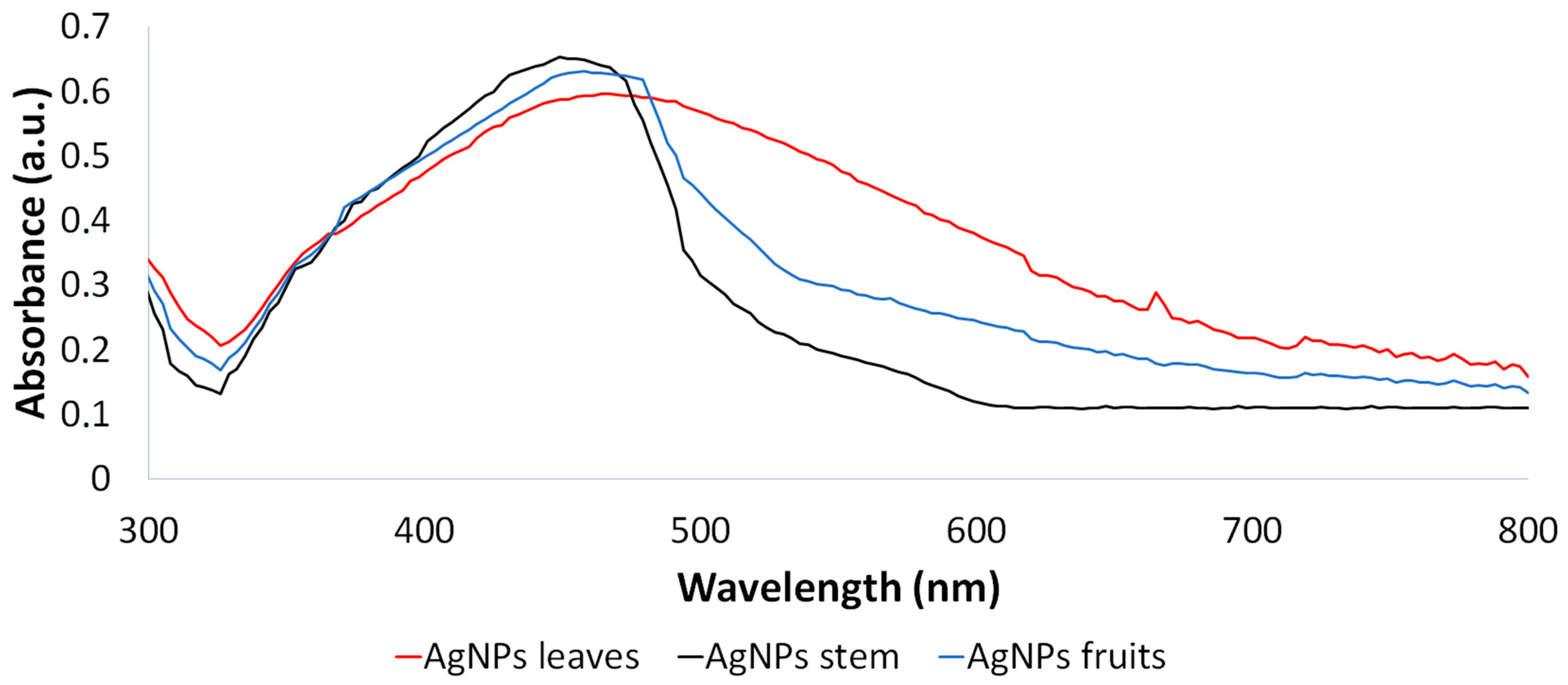
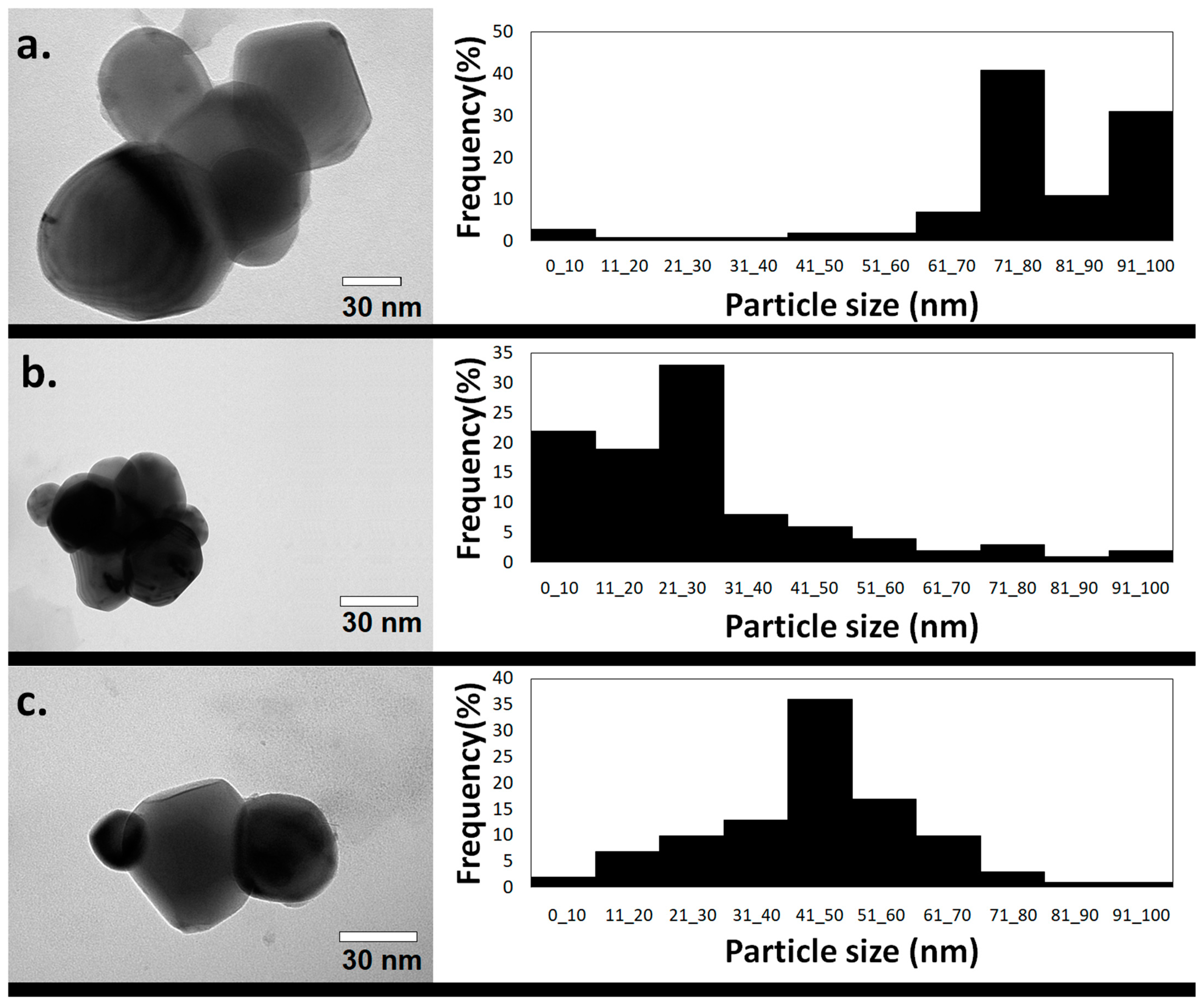

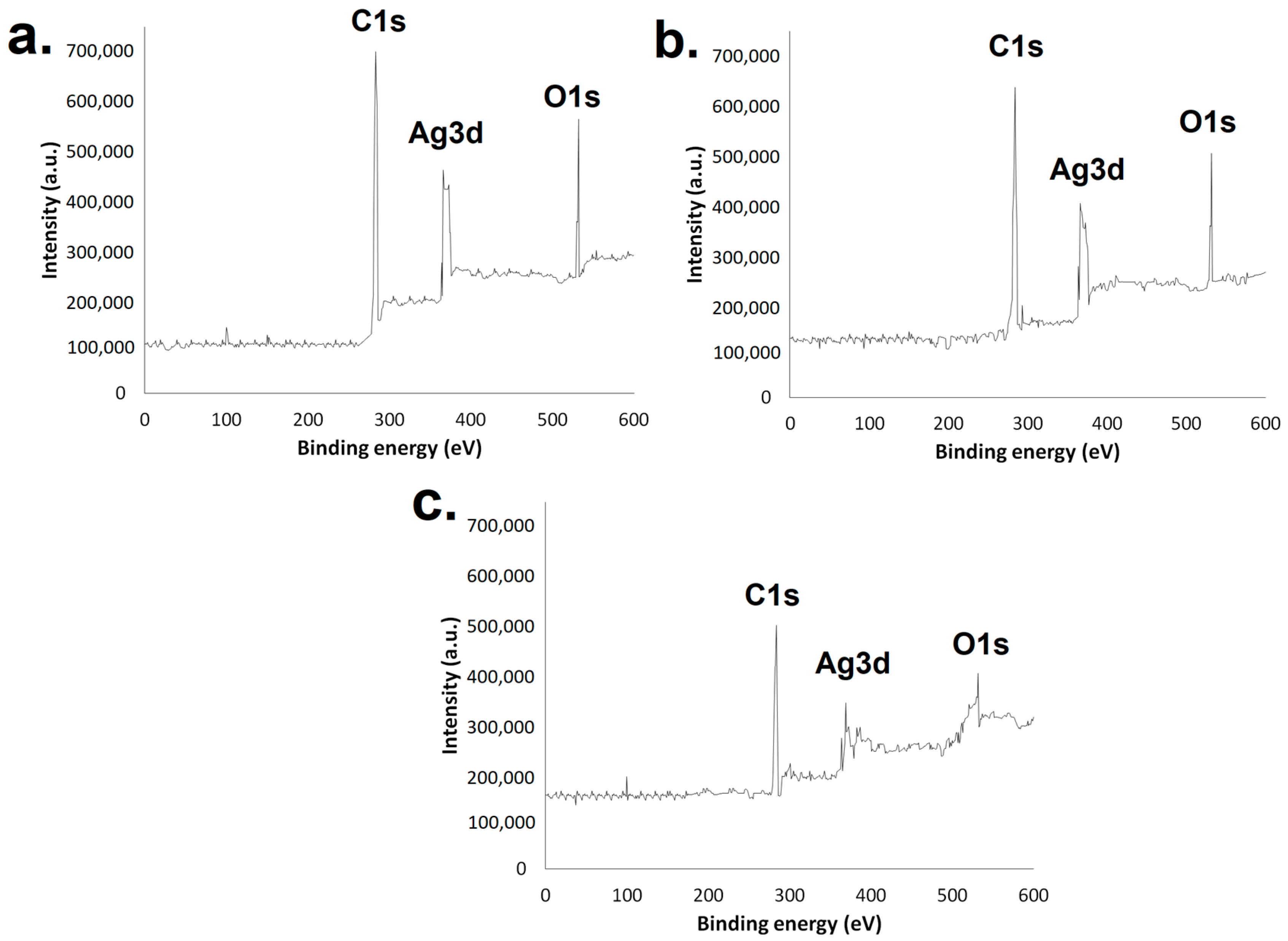
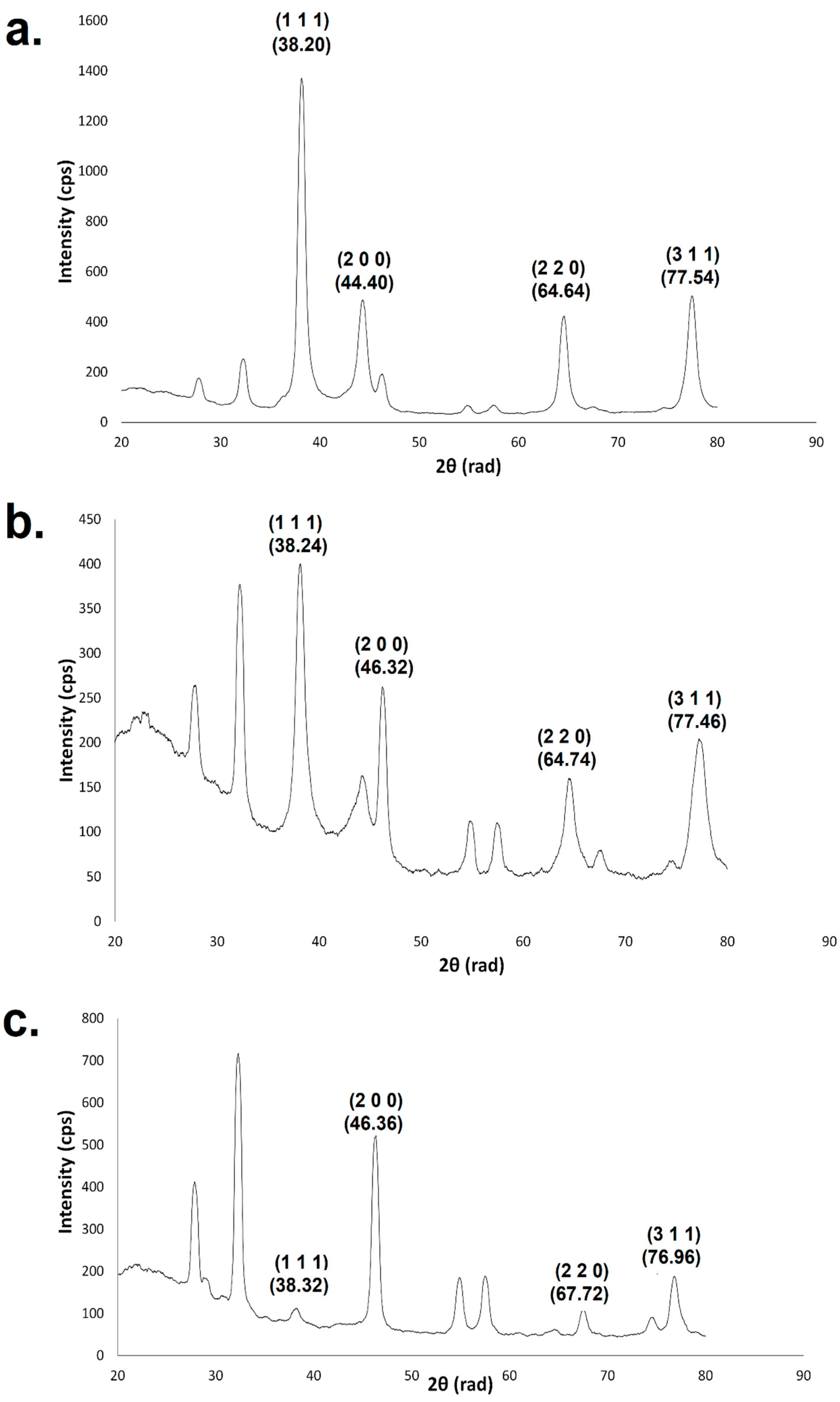

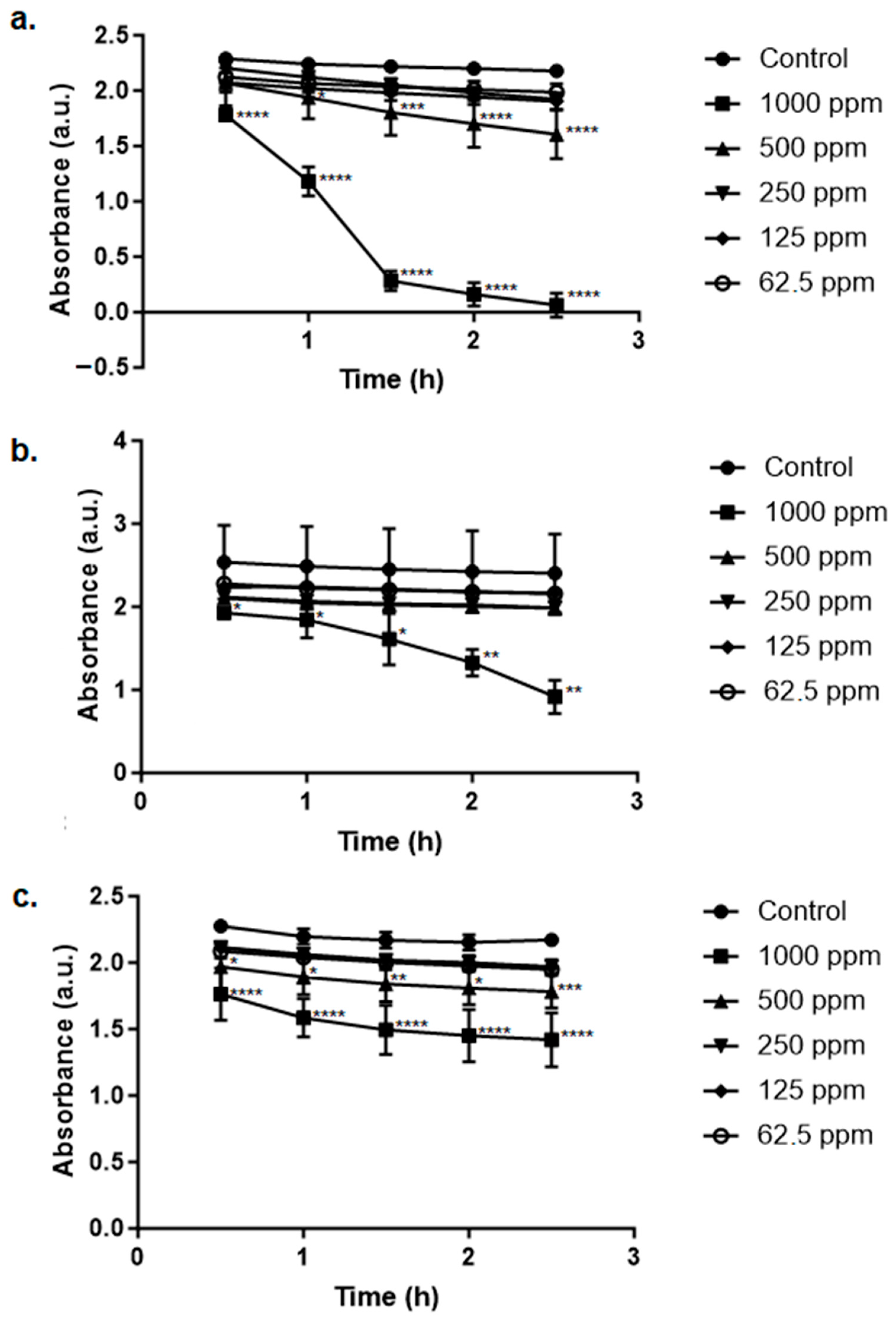

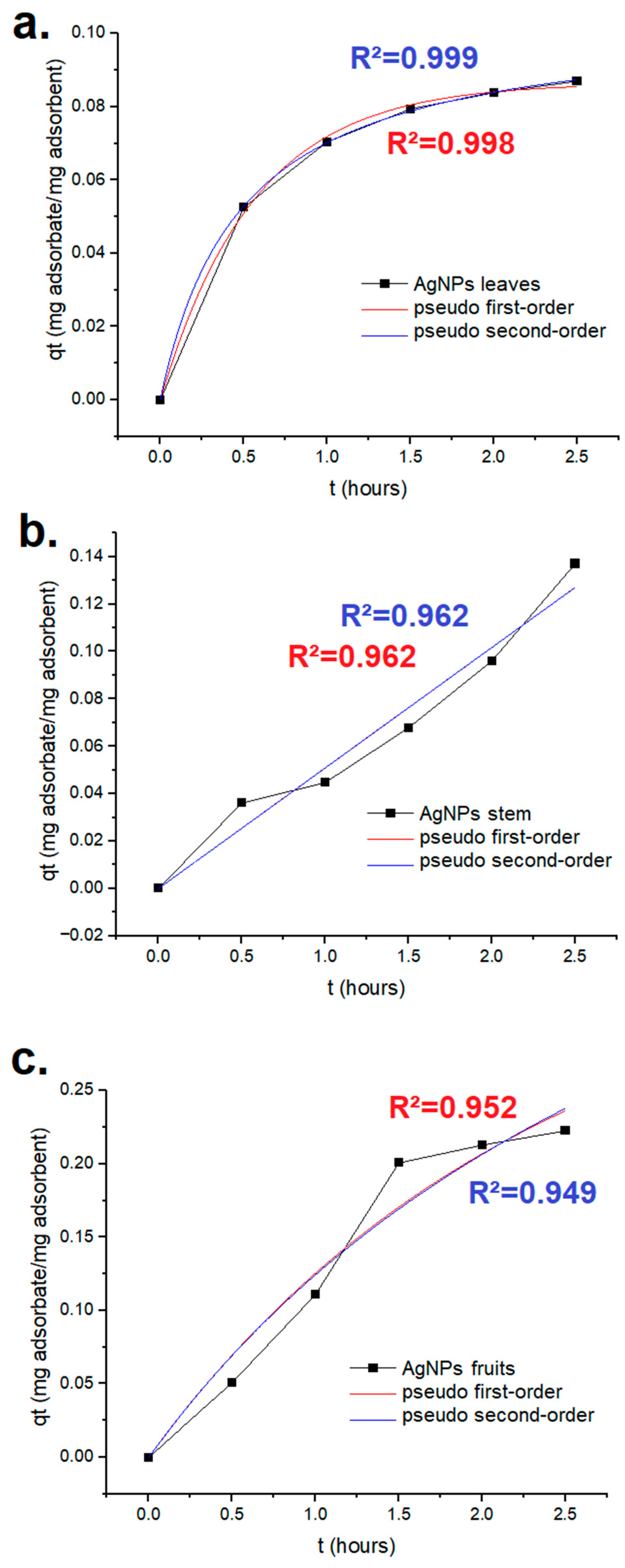
| Temperatures | Phenolic Compounds’ Dosage (mg/g of Vegetal Material) | ||
|---|---|---|---|
| Leaves | Stem | Fruits | |
| 20 °C | 239.97 ± 0.03 | 429.75 ± 0.01 | 122.29 ± 0.07 |
| 40 °C | 242.73 ± 0.04 | 527.89 ± 0.05 | 130.27 ± 0.02 |
| 60 °C | 248.00 ± 0.04 | 795.84 ± 0.07 | 168.97 ± 0.05 |
| 80 °C | 323.41 ± 0.01 | 835.41 ± 0.04 | 183.02 ± 0.16 |
| 100 °C | 257.43 ± 0.04 | 737.89 ± 0.01 | 152.48 ± 0.07 |
| Time Intervals (min) | Phenolic Compounds’ Dosage (mg/g of Vegetal Material) | ||
|---|---|---|---|
| Leaves | Stem | Fruits | |
| 10 | 289.72 ± 0.01 | 715.67 ± 0.03 | 164.25 ± 0.02 |
| 20 | 383.95 ± 0.17 | 835.41 ± 0.04 | 183.02 ± 0.08 |
| 30 | 379.01 ± 0.11 | 833.48 ± 0.11 | 197.58 ± 0.01 |
| 40 | 382.15 ± 0.09 | 829.28 ± 0.07 | 191.25 ± 0.02 |
| 50 | 384.15 ± 0.22 | 834.15 ± 0.05 | 193.45 ± 0.17 |
| 60 | 383.99 ± 0.11 | 832.59 ± 0.10 | 183.19 ± 0.08 |
| Proportion Silver Nitrate:Extract | Methylene Blue | Tartrazine | ||||
|---|---|---|---|---|---|---|
| Leaves | Stem | Fruits | Leaves | Stem | Fruits | |
| 1:1 | 55.5% | 4.25% | 9.99% | 20.17% | 9.15% | 10.03% |
| 1:2 | 57.89% | 9.55% | 12.25% | 27.89% | 19.84% | 10.57% |
| 1:3 | 64.61% | 10.79% | 15.48% | 34.15% | 22.59% | 10.89% |
| 1:4 | 67.79% | 11.27% | 17.86% | 34.78% | 27.84% | 12.44% |
| 1:5 | 69.45% | 21.49% | 20.28% | 45.71% | 31.12% | 12.59% |
| 1:6 | 77.79% | 33.28% | 21.57% | 50.71% | 38.74% | 14.75% |
| 1:7 | 77.49% | 45.15% | 25.87% | 61.83% | 45.18% | 14.78% |
| 1:8 | 80.57% | 52.17% | 34.65% | 79.48% | 49.17% | 16.49% |
| 1:9 | 100.00% | 62.81% | 34.62% | 100.00% | 61.67% | 16.51% |
| 1:10 | 71.08% | 45.78% | 30.79% | 87.91% | 47.12% | 15.49% |
| AgNPs Concentration (µg/mL) | AgNPs % of Inhibition | BHT % of Inhibition | ||
|---|---|---|---|---|
| Leaves | Stem | Fruits | ||
| 1 | 35.10 ± 0.50 | 30.92 ± 2.05 | 33.27 ± 3.52 | 37.03 ± 3.28 |
| 10 | 41.37 ± 1.00 | 30.84 ± 0.00 | 32.29 ± 1.16 | 34.62 ± 0.37 |
| 100 | 53.17 ± 1.14 | 38.23 ± 0.57 | 32.29 ± 1.16 | 40.48 ± 0.64 |
| 250 | 62.41 ± 1.47 ** | 45.62 ± 0.74 | 35.49 ± 1.41 | 45.78 ± 1.05 |
| 500 | 79.04 ± 4.74 ** | 49.64 ± 0.24 | 40.38 ± 1.23 | 53.17 ± 0.45 |
Disclaimer/Publisher’s Note: The statements, opinions and data contained in all publications are solely those of the individual author(s) and contributor(s) and not of MDPI and/or the editor(s). MDPI and/or the editor(s) disclaim responsibility for any injury to people or property resulting from any ideas, methods, instructions or products referred to in the content. |
© 2024 by the authors. Licensee MDPI, Basel, Switzerland. This article is an open access article distributed under the terms and conditions of the Creative Commons Attribution (CC BY) license (https://creativecommons.org/licenses/by/4.0/).
Share and Cite
Silva, C.S.; Tonelli, F.M.P.; Delgado, V.M.S.; Lourenço, V.d.O.; Pinto, G.d.C.; Azevedo, L.S.; Lima, L.A.R.d.S.; Furtado, C.A.; Ferreira, D.R.C.; Tonelli, F.C.P.; et al. Nanoremediation and Antioxidant Potential of Biogenic Silver Nanoparticles Synthesized Using Leucena’s Leaves, Stem, and Fruits. Int. J. Mol. Sci. 2024, 25, 3993. https://doi.org/10.3390/ijms25073993
Silva CS, Tonelli FMP, Delgado VMS, Lourenço VdO, Pinto GdC, Azevedo LS, Lima LARdS, Furtado CA, Ferreira DRC, Tonelli FCP, et al. Nanoremediation and Antioxidant Potential of Biogenic Silver Nanoparticles Synthesized Using Leucena’s Leaves, Stem, and Fruits. International Journal of Molecular Sciences. 2024; 25(7):3993. https://doi.org/10.3390/ijms25073993
Chicago/Turabian StyleSilva, Christopher Santos, Fernanda Maria Policarpo Tonelli, Vinicius Marx Silva Delgado, Vitória de Oliveira Lourenço, Geicielly da Costa Pinto, Lucas Santos Azevedo, Luciana Alves Rodrigues dos Santos Lima, Clascídia Aparecida Furtado, Danilo Roberto Carvalho Ferreira, Flávia Cristina Policarpo Tonelli, and et al. 2024. "Nanoremediation and Antioxidant Potential of Biogenic Silver Nanoparticles Synthesized Using Leucena’s Leaves, Stem, and Fruits" International Journal of Molecular Sciences 25, no. 7: 3993. https://doi.org/10.3390/ijms25073993
APA StyleSilva, C. S., Tonelli, F. M. P., Delgado, V. M. S., Lourenço, V. d. O., Pinto, G. d. C., Azevedo, L. S., Lima, L. A. R. d. S., Furtado, C. A., Ferreira, D. R. C., Tonelli, F. C. P., & Parreira, A. G. (2024). Nanoremediation and Antioxidant Potential of Biogenic Silver Nanoparticles Synthesized Using Leucena’s Leaves, Stem, and Fruits. International Journal of Molecular Sciences, 25(7), 3993. https://doi.org/10.3390/ijms25073993








